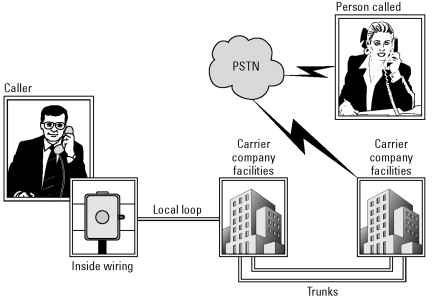When digital networks were introduced, the phone companies wanted to use them right away because they provided a more efficient means of transmitting signals all over the place. (Digital networks could carry data much faster than analog networks.) The phone companies were presented with a problem, however: how to make existing analog phones work with a digital network.
The answer was to use a codec to convert the analog signal to digital. But where should the conversion take place? At the phone company’s facilities or at their customer’s location? In the early years of the digital revolution, the conversion took place at the phone company’s facilities, which allowed the phone company to utilize the existing wiring between their facilities and the customer’s location. This wiring between a phone company facility and a customer is often called a local loop.
Over the years, the codec has been pushed closer and closer to the customer, all in an effort to make the phone network as close to 100 percent digital as possible. Most parts of the PSTN remain a combination of analog and digital. Customers pick up a phone, which converts audible sound into analog signals. These signals are carried over the local loop to the phone carrier’s facilities, where they are converted to a digital signal. The signals are forwarded to the receiver’s end. After the signals are received by the last piece of carrier equipment (closest to the end customer), they are converted back to analog form. The analog signals go into the receiver side of the POTS telephone and are heard as a replica of the caller’s voice. Figure 2-1 illustrates how a phone call is transmitted over the PSTN.
Calling Pennsylvania 6-5000
In the 1940s, a consortium of leaders in the telecommunications industry and in government standardized how customers would be assigned telephone numbers. The telephone number identified a specific pair of wires out of millions of pairs of wires, and a specific phone company switch out of thousands of such devices. The term circuit-switched describes this setup of circuit wiring, switching devices, and telephone number assignment. The PSTN is sometimes referred to as the circuit-switched or switched network.
Because today’s public phone system is still circuit-switched, it still relies on the same basic
system for telephone number assignment. VoIP introduced dramatic changes in how the network is used and, over time, VoIP could force changes in how numbers are assigned. With VoIP, phone numbers are no longer tied to specific wires and switches. VoIP routes calls based on network addresses, and phone numbers are simply used because that is what people are familiar with. (VoIP takes care of translating a phone number into a network address.) In the future, as more and more people adopt VoIP-based systems, we may see dramatic changes in phone numbering.

Figure 2-1: A typical PSTN telephone connection.
Today, a customer can have either an analog or a digital phone. Depending on customer location and end-user equipment, the POTS call can be 100 percent digital.
For more than a century, POTS remained the dominant form of two-way telecommunications. During that time, however, POTS-based telephone systems changed dramatically in the number, length, diameter, and type of wire or cables used and in the types of telephone equipment both at the customer end and at the carrier’s facilities
